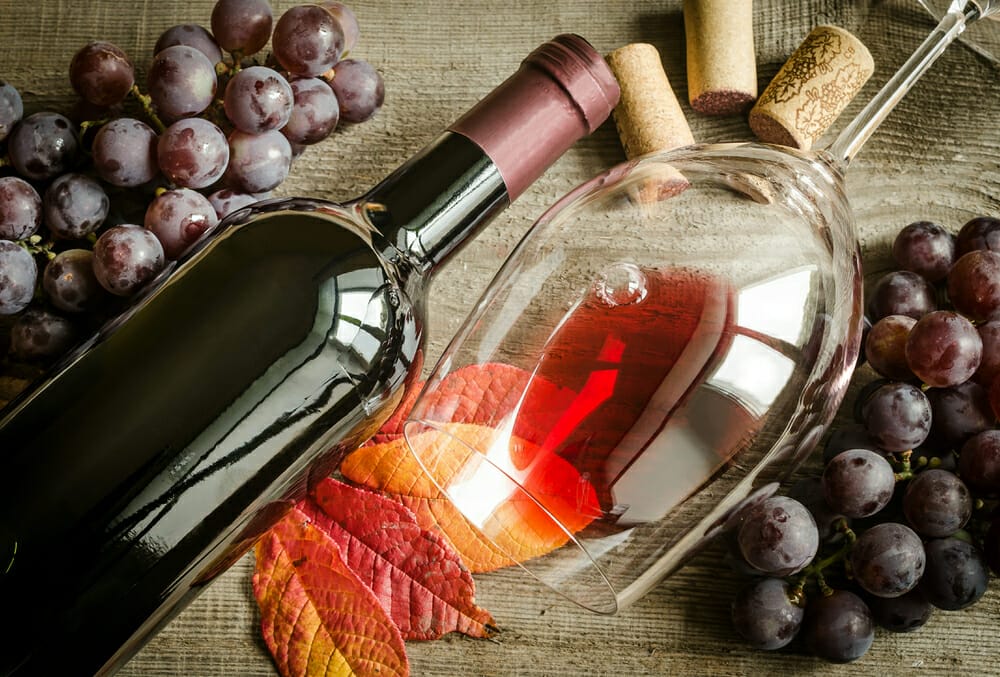If Jesus turned water into wine, did he make a Malbec or a Shiraz?
In a world where the options for wine are endless, we might find certain similarities between a few.
While Malbec and Shiraz are both full-bodied red wines that pair well with many dishes, there are numerous differences that completely set the two apart!
Whether you’re an aspiring sommelier or simply looking to get to know your wines better, this article will explain 9 key differences between Malbec and Shiraz so that your next dinner party has the perfect wine to match!
This article will discuss:
- The characteristics of each wine, based on their taste, sweetness, and dryness
- The region in which they are mainly produced
- Their complexity, level of alcohol, average cost, and color
- The soil and weather conditions that allow for the best growth
- How long each wine lasts.
By the end of the article, you’ll be a Malbec vs. Shiraz pro and capable of telling the difference between them with no problem whatsoever. Let’s get into it!
Comparisons

To compare the two wines, we’ll go through characteristics that you’d see in all wines. Then, we’ll talk about the difference between Malbec and Shiraz.
Regional differences
Both Shiraz and Malbec wines originated in France, where their grapes were grown.
Malbec grapes come from Cahors, a small town in the Occitanie region of France.
Shiraz, also known by its French name, Syrah, originated in a small valley – Rhône Valley – in the Auvergne-Rhône-Alpes region.
Nowadays, the grapes of these two wines are mostly grown in two different countries.
Malbec grapes are now notably grown in the Mendoza region of Argentina when only a few vines were planted in the mid-1800s after being brought over from France.
Malbec grapes and wine have now become part of Argentinian culture, and a part of their national identity.
Shiraz grapes are grown mainly in Australia. They were brought over from Europe in 1832 but didn’t gain consistent popularity for wine until the late 1900s.
Now, they are Australia’s most favored grape for Wine, with Shiraz gaining notable attention as an Australian wine – similar to that of Argentina and Malbec.
Growing conditions
Because the ripening of the grape has a lot to do with the climate, Malbec grapes grow best in warm and sunny climates that cool down in the nighttime.
This means that the grape can ripen and also preserve its acidity as the day cools down.
Malbec grapes don’t like too much water as the roots can become overly soaked. Because of this, the soil needs to be efficient at draining water – providing just the right amount to create a perfect grape and wine.
Shiraz also relies on a warm and sunny climate for the ripening of the grape.
Because Shiraz wines lean slightly sweeter, a more humid climate is beneficial for greater sugar production. Similar to our friend, Malbec, a cool night is key for preserving and developing these sugars and acidities. They require even less water and often grow well in sandy or grainy soils.
Flavor and taste
The flavor profiles of the two wines are completely unique to one another. Once you understand what you’re searching for, you’ll have no problem identifying one from the other!
Malbec is known for its jammy flavor. Its flavor can vary based on where and how it was produced, but many notes will stay the same.
A Malbec’s flavor profile can be described as fruity, with notes of plum, blackberry, and cherry. A vanilla or tobacco flavor can also be found through the aging process.
As Malbec is often aged in barrels made from oak, a deeper, more chocolatey, or coffee-like flavor can also shine through. Tannins come from the grape skin and seed, and in wines, add to the natural bitter flavor — contributing to the grippy feel of a Malbec on the tongue.
Shiraz definitely contains some similarities to Malbec. However, it also has its own distinct flavors that set it apart. Shiraz is bold and fruity, containing strong notes of blueberry and blackberry, balanced by spices such as black pepper and clove which add to the depth of the wine.
It can be distinctly chocolatey, smokey, and leathery — again due to the aging process — and can even contain notes of tobacco. Depending on where it is grown, flowery and herby aromas may also poke through, such as lavender.
Sweetness and dryness
Now that we’ve talked about flavor profiles, let’s discuss the sweetness and dryness of each wine!
Wines are often profiled by how sweet or dry they are. This is determined after their processing and mainly influences how well they go with certain foods, as well as personal preferences.
Malbec is a typically dry wine, thanks to its fruity notes we previously discussed in its flavor profile. It sits somewhere in the middle on the scale between sweet and super dry.
Some residual sugar from the fruit is present, contributing to its sweetness. However, it ultimately leans toward the drier side.
Shiraz is also a dry wine, which is why the two are often compared. However, due to its notes of chocolate and vanilla, Shiraz is slightly sweeter (or semi-sweet). In some cases, the flowery nature of a Shiraz (such as when lavender is present) will cause the wine to contain more residual sugar and therefore lean even sweeter.
In summary, both wines are dry, with Shiraz leaning ever so slightly sweeter.
Complexity
Let’s move on to complexity, shall we?
The complexity of wine can mean many things, but in simple terms, it refers to the amount of layering and aroma present in a wine and how balanced and rounded the wine is.
Factors that contribute to complexity can be aspects such as aging, regions, and how long the wine takes to be made. The complexity of Malbec and Shiraz can often be further highlighted through food pairings.
Malbec’s complexity lies in the presence of tannins and the process of oak aging. Tannins, as previously discussed, come from the grape skin and seeds and result in a grippy feeling on the mouth that may stay during the drinking process.
The oak aging in barrels means that the wine develops more musky notes and flavor from that alone. During the aging process, tannins can develop, break down, and settle — rounding out the wine overall. Various processes such as regions of production can vary the flavor and complexity between different Malbecs.
Shiraz contains even more tannins, meaning that the aging process has the potential to stretch out. The aging of any red wine contributes to its complexity — and in the case of Shiraz, this is definitely the case!
The flavors present in Shiraz such as tobacco, leather, and coffee all come from the aging process and development, and they all heavily contribute to the complexity of Shiraz.
Lightness and heaviness
Lightness and heaviness are also terms used to differentiate and profile different wines. Malbec and Shiraz both have different weights to them.
Malbecs can vary in heaviness. Some are light, while others are much more full-bodied. Usually, this has a lot to do with the ripeness of the grape when it is harvested.
Malbec is most commonly medium-bodied, making it a good companion with a variety of foods and dishes. The medium-bodied Malbec will balance its flavors well while maintaining a strong essence overall.
Shiraz also commonly turns out as medium-bodied, although it can also lean to be more full-bodied. This means that the fruity flavors and number of tannins take their place strongly in a glass. A full-bodied shiraz can also pair wonderfully with a variety of foods, particularly steak.
Coloring
The color of both wines may simply present as red. However, the hue of each can give some hints about the flavors one can expect when you take that first sip.
Malbec wine is typically a dark purple color. It can start out as more ruby red, but as it ages, it slowly but surely develops a dark purple hue. The clarity of the wine can also contribute to the color. For example, a completely clear Malbec might appear as mainly purple with a red halo.
Shiraz is very similar in coloring, though this is of course dependent on the winemaker, grapes, and process of creation. Shiraz presents more ruby red than purple, but can also lean violet like Malbec.
Now that we have mentioned the flavor, growing conditions, and physical characteristics of the two wines, we can compare how well they compare as wines to buy.
Cost
Both wines vary in cost, influenced by a number of reasons such as where they were produced, the grapes, the brand, and so on.
Malbec is usually the more affordable option, as its average price ranges between $6 and $15. Of course, there are more expensive options for all sorts of occasions.
Shiraz can also be an affordable wine, though it can reach much higher prices due to its aging process. As we now know, Shiraz has more tannins — meaning it can be and is aged longer than a Malbec. Because it takes longer to produce, you’ll find an average price of between $10 – $27.
Alcohol content
Malbec wines sit at an average of between 13.5% and 15.5% alcohol content by volume (ABV). Of course, this is just an average, and some Malbecs can be both higher and lower than this.
Shiraz, like its price, tends to lean a little higher in alcohol content. It usually starts around 14% and goes to around 16% ABV. Again, this can vary between different brands and regions of production.
Shelf life

After opening the bottle, wine should be consumed relatively quickly to prevent further fermentation not desired in certain wines. Undesirable aspects like acidity and sourness can quickly show if the wine is left for too long.
Depending on whether or not the Malbec is medium-bodied, light, or heavy, it can last for around 5-6 days. Because of the tannins present in both Malbec and Shiraz, they can both stay open on average longer than a white wine or lighter red.
Again, depending on the body of the wine (medium, heavy, or light), Shiraz can usually stay open for about 3-5 days after opening.
It’s debated whether or not to keep red wine in the fridge, which typically comes down to personal preference. Sometimes, refrigeration can slow the souring of a wine – making it last longer.
That brings us to the end of our comparisons of characteristics between a Malbec wine and a Shiraz.
So, which wine should you choose in what situation?
Each food pairing for wine comes down to personal preference. Red wines are typically matched with hearty meals that demand attention.
Malbec pairs extremely well with red meats such as steak and venison. Its oaky flavor balances well with grilled vegetables and pickled or fermented foods such as olives and herbs. My personal perfect dish with a Malbec would be a grilled steak with rich vegetables!
Shiraz also pairs wonderfully with red meat and grilled foods. However, it is particularly great with spicy food such as hot curries due to its fruity and peppery qualities. Although it isn’t a dessert wine, many enjoy a glass in winter with dark chocolate!
Let’s summarize the differences and similarities with a table:
| Characteristic | Malbec | Shiraz |
| Region | Argentina, Cohers | Australia, Rhone Valley |
| Growing Conditions | Warm and Sunny, Cool Nights. Draining soil | Warm and Sunny, Cool Nights. Sandy soil |
| Flavour | Plum, Cherry, Blackberry, Chocolate, Coffee, Vanilla | Blackberry, Blueberry, Clove, Pepper, Leather, Tobacco |
| Dryness | Medium Dry – Dry | Medium Dry – Semi Dry |
| Complexity | Musky, Layered, Grippy | Fruity, Rounded, Balanced |
| Heaviness | Medium – Full Bodied | Medium – Full Bodied |
| Coloring | Dark Purple | Ruby – Dark Purple |
| Cost | $6 – $15 | $10 – $27 NZD |
| Alcohol Content | 13.5% – 15.5% | 14% – 16% |
| Shelf Life | 5-6 Days once opened | 3-5 Days once opened |
Overall, it’s important to remember that wine preference is utterly personal — and that’s what makes it so enjoyable!
I would recommend trying both wines for yourself to gauge exactly what it is that you prefer with certain meals. Hopefully, after reading this article, you can make a more informed decision about which red suits your every occasion.
So, will it be a Malbec or a Shiraz? Happy wine tasting!
FAQs
Malbec and Shiraz have differences that set them apart from each other. A Malbec’s flavor profile can be described as fruity with notes of plum, blackberry, vanilla, and tobacco. Shiraz can be described as bold and fruity, with strong notes of blueberry, blackberry, black pepper, and clove.
Both wines sit at around the same sweetness, but Shiraz leans slightly sweeter due to higher levels of residual sugar and tannins.
Shiraz and Malbec are both considered to be dry wines, but Malbec is slightly dryer due to its darker fruity notes.
All three wines are red with grapes originating from France. Merlot is more different from the other two wines, with its fruity qualities being raspberry and cherry instead of blackberry, blueberry, and plum.
All three have different tannin levels, with Merlot being the lowest and Shiraz the highest. Lighter tannins make a wine slightly more approachable.
Class in wine comes down to personal preference. However, both Malbec and Shiraz are considered to be quite classy due to the lengthy process and intense complexity displayed in both wines. Merlot and Pinot Noir are also considered quite classy.
Shiraz and Malbec do have similar qualities, taste, tannin levels, and appearance. They both pair well with similar foods such as red meat and grilled foods. There are many differences for a more sophisticated comparison, but the two are definitely similar to each other.
- Moscato vs Roscato: A Comprehensive Comparison of Sweet Wines - December 15, 2023
- Should White Wine Be Chilled? Expert Insights on Serving Temperature - December 14, 2023
- Moscato vs Riesling: A Sweet Wine Showdown - December 8, 2023








![Malbec Vs Pinot Noir: 8 Important Differences [2023] Malbec Vs Pinot Noir](https://e25kn4v6x6d.exactdn.com/wp-content/uploads/2023/09/Malbec-Vs-Pinot-Noir.jpg?strip=all&lossy=1&resize=150%2C150&ssl=1)

